Conjoined twins
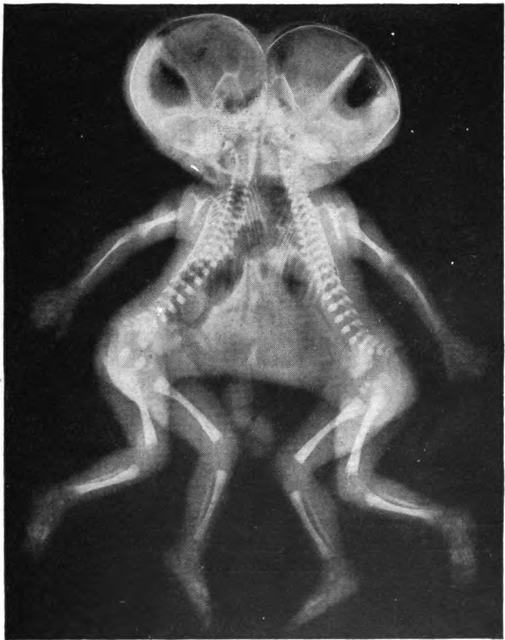
Conjoined twins

| Conjoined twins | |
|---|---|
| Other names | Siamese twins |
| X-ray of conjoined twins, cephalothoracopagus. | |
| Specialty | Medical genetics |
Conjoined twins are identical twins[1] joined in utero. An extremely rare phenomenon, the occurrence is estimated to range from 1 in 49,000 births to 1 in 189,000 births, with a somewhat higher incidence in Southwest Asia and Africa.[2] Approximately half are stillborn, and an additional one-third die within 24 hours. Most live births are female, with a ratio of 3:1.[2][3]
Two contradicting theories exist to explain the origins of conjoined twins. The more generally accepted theory is fission, in which the fertilized egg splits partially.[4] The other theory, no longer believed to be the basis of conjoined twinning,[4] is fusion, in which a fertilized egg completely separates, but stem cells (which search for similar cells) find similar stem cells on the other twin and fuse the twins together. Conjoined twins share a single common chorion, placenta, and amniotic sac, although these characteristics are not exclusive to conjoined twins, as there are some monozygotic but non-conjoined twins who also share these structures in utero.[5]
Chang and Eng Bunker (1811–1874), Thai brothers born in Siam, now Thailand, traveled widely for many years and were labeled as The Siamese Twins. Chang and Eng were joined at the torso by a band of flesh, cartilage, and their fused livers. In modern times, they could have been easily separated.[6] Due to the brothers' fame and the rarity of the condition, the term "Siamese twins" came to be used as a synonym for conjoined twins.[7]
| Conjoined twins | |
|---|---|
| Other names | Siamese twins |
| X-ray of conjoined twins, cephalothoracopagus. | |
| Specialty | Medical genetics |
Types
Conjoined twins are typically classified by the point at which their bodies are joined. The most common types of conjoined twins are:
Thoraco-omphalopagus (28% of cases):[4] Two bodies fused from the upper chest to the lower chest. These twins usually share a heart, and may also share the liver or part of the digestive system.[8]
Thoracopagus (18.5%):[4] Two bodies fused from the upper thorax to lower belly. The heart is always involved in these cases.[8] As of 2015, separation of a genuinely shared heart has not offered survival to two twins; a designated twin may survive if allotted the heart, sacrificing the other twin.
Omphalopagus (10%):[4] Two bodies fused at the lower abdomen. Unlike thoracopagus, the heart is never involved in these cases; however, the twins often share a liver, digestive system, diaphragm and other organs.[8]
Parasitic twins (10%):[4] Twins that are asymmetrically conjoined, resulting in one twin that is small, less formed, and dependent on the larger twin for survival.
Craniopagus (6%):[4] Fused skulls, but separate bodies. These twins can be conjoined at the back of the head, the front of the head, or the side of the head, but not on the face or the base of the skull.[8]
Other, less common types of conjoined twins include:
Cephalopagus: Two faces on opposite sides of a single, conjoined head; the upper portion of the body is fused while the bottom portions are separate. These twins generally cannot survive due to severe malformations of the brain. Also known as janiceps (after the two-faced Roman deity Janus) or syncephalus.[8]
Syncephalus: One head with a single face but four ears, and two bodies.[8]
Cephalothoracopagus: Bodies fused in the head and thorax. In this type of twins, there are two faces facing in opposite directions, or sometimes a single face and an enlarged skull.[8][9]
Xiphopagus: Two bodies fused in the xiphoid cartilage, which is approximately from the navel to the lower breastbone. These twins almost never share any vital organs, with the exception of the liver.[8] A famous example is Chang and Eng Bunker.
Ischiopagus: Fused lower half of the two bodies, with spines conjoined end-to-end at a 180° angle. These twins have four arms; one, two, three or four legs; and typically one external set of genitalia and anus.[8]
Omphalo-Ischiopagus: Fused in a similar fashion to ischiopagus twins, but facing each other with a joined abdomen akin to omphalopagus. These twins have four arms, and two, three, or four legs.[8]
Parapagus: Fused side-by-side with a shared pelvis. Twins that are dithoracic parapagus are fused at the abdomen and pelvis, but not the thorax. Twins that are diprosopic parapagus have one trunk and two faces. Twins that are dicephalic parapagus have one trunk and two heads, and have two (dibrachius), three (tribrachius), or four (tetrabrachius) arms.[8]
Craniopagus parasiticus: Like craniopagus, but with a second bodiless head attached to the dominant head.
Pygopagus or Iliopagus: Two bodies joined at the pelvis.[8]
Rachipagus: Twins joined along the back of their bodies, with fusion of the vertebral arches and the soft tissue from the head to the buttocks[10]
Causes
There are two theories about the development of conjoined twins. The first is that a single fertilized egg does not fully split during the process of forming identical twins. The second theory is that a fusion of two fertilized eggs occurs earlier in development. Although conjoined twinning has not been linked to any environmental or genetic cause, they occur so rarely it has not been possible to draw firm conclusions.
Management
Separation
Surgery to separate conjoined twins may range from very easy to very difficult depending on the point of attachment and the internal parts that are shared. Most cases of separation are extremely risky and life-threatening. In many cases, the surgery results in the death of one or both of the twins, particularly if they are joined at the head or share a vital organ. This makes the ethics of surgical separation, where the twins can survive if not separated, contentious. Alice Dreger of Northwestern University found the quality of life of twins who remain conjoined to be higher than is commonly supposed.[11] Lori and George Schappell and Abby and Brittany Hensel are notable examples.
The first record of separating conjoined twins took place in the Byzantine Empire in the 900s. One of the conjoined twins had already died, so surgeons attempted to separate the dead twin from the surviving twin. The result was partly successful as the remaining twin lived for three days after separation. The next case of separating conjoined twins was recorded in 1689 in Germany several centuries later.[12][13] The first recorded successful separation of conjoined twins was performed in 1689 by Johannes Fatio.[14] In 1955, neurosurgeon Harold Voris (1902-1980)[15] and his team at Mercy Hospital in Chicago performed the first successful operation to separate craniopagus twins (conjoined at the head), which resulted in long-term survival for both.[16][17][18] The larger girl was reported in 1963 as developing normally, but the smaller was permanently impaired.[19]
In 1957, Bertram Katz and his surgical team made international medical history performing the world's first successful separation of conjoined twins sharing a vital organ.[20] Omphalopagus twins John Nelson and James Edward Freeman (Johnny and Jimmy) were born in Youngstown, Ohio, on April 27, 1956. The boys shared a liver but had separate hearts and were successfully separated at North Side Hospital in Youngstown, Ohio, by Bertram Katz. The operation was funded by the Ohio Crippled Children's Service Society.[21]
Recent successful separations of conjoined twins include that of the separation of Ganga and Jamuna Shreshta in 2001, who were born in Kathmandu, Nepal, in 2000. The 97-hour surgery on the pair of craniopagus twins was a landmark one which took place in Singapore; the team was led by neurosurgeons Chumpon Chan and Keith Goh.[22] The surgery left Ganga with brain damage and Jamuna unable to walk. Seven years later, Ganga Shrestha died at the Model Hospital in Kathmandu in July 2009, at the age of eight, three days after being admitted for treatment of a severe chest infection.[23]
Infants Rose and Grace Attard, conjoined twins from Malta, were separated in Great Britain by court order Re A over the religious objections of their parents, Michaelangelo and Rina Attard. The twins were attached at the lower abdomen and spine. The surgery took place in November, 2000, at St Mary's Hospital in Manchester. The operation was controversial because Rose, the weaker twin, would die as a result of the procedure as her heart and lungs were dependent upon Grace's. However, if the operation had not taken place, it was certain that both twins would die.[24][25] Grace survived to enjoy a normal childhood.[26]
In 2003, two 29-year-old women from Iran, Ladan and Laleh Bijani, who were joined at the head but had separate brains (craniopagus) were surgically separated in Singapore, despite surgeons' warnings that the operation could be fatal to one or both. Their complex case was accepted only because technologically advanced graphical imagery and modelling would allow the medical team to plan the risky surgery. However, an undetected major vein hidden from the scans was discovered during the operation.[27] The separation was completed but both women died while still in surgery.
In 2019 Safa and Marwa Ullah were separated at Great Ormond Street Hospital in London, England. The twins, born January 2017 were joined at the top of the head with separate brains and a cylindrical shared skull with the twins each facing in opposite directions to one another. The surgery was jointly led by neurosurgeon Owase Jeelani and plastic surgeon Professor David Dunaway. The surgery presented particular difficulties due to a number of shared veins and a distortion in the shape of the girls brains, causing them to overlap. The distortion would need to be corrected in order for the separation to go ahead. The surgery utilized a team of more than 100 including bio engineers, 3D modelers and a virtual reality designer. The separation was completed in February 2019 following a total of 52 hours of surgery over three separate operations. As of July 2019 both girls remain healthy and the family plans to return to their home in Pakistan in 2020[28][29]
History
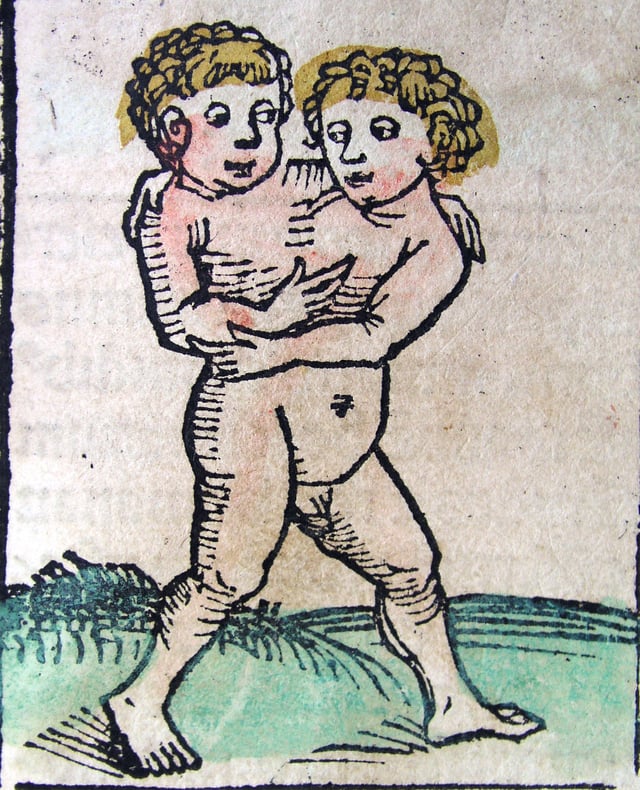
Conjoined brothers from Nuremberg Chronicle (1493)
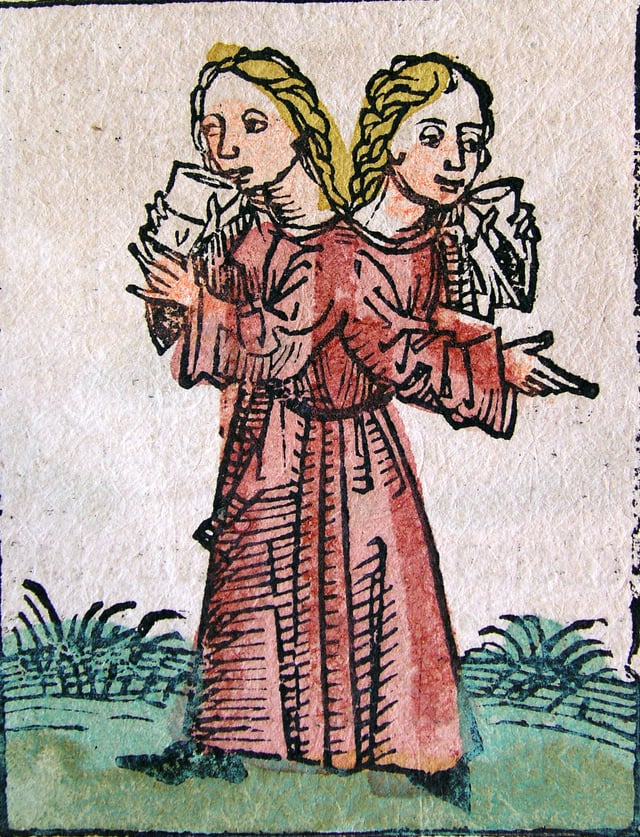
Conjoined twin sisters from Nuremberg Chronicle (1493)
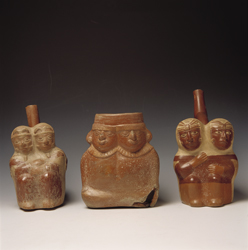
Moche ceramics depicting conjoined twins. 300 CE Larco Museum Collection Lima, Peru.
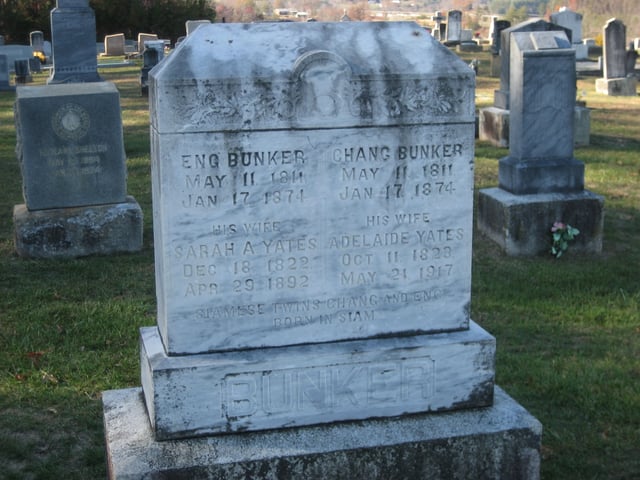
Grave of Eng and Chang Bunker near Mt. Airy, North Carolina
The Moche culture of ancient Peru depicted conjoined twins in their ceramics dating back to 300 CE.[30] Writing around 415 CE, St. Augustine of Hippo, in his book, City of God, refers to a man "double in his upper, but single in his lower half--having two heads, two chests, four hands, but one body and two feet like an ordinary man."[31]
According to Theophanes the Confessor, a Byzantine historian of the 9th century, around 385/386 CE, "in the village of Emmaus in Palestine, a child was born perfectly normal below the navel but divided above it, so that it had two chests and two heads, each possessing the senses. One would eat and drink but the other did not eat; one would sleep but the other stayed awake. There were times when they played with each other, when both cried and hit each other. They lived for a little over two years. One died while the other lived for another four days and it, too, died."[32]
In Arabia, the twin brothers Hashim ibn Abd Manaf and 'Abd Shams were born with Hashim's leg attached to his twin brother's head. Legend says that their father, Abd Manaf ibn Qusai, separated his conjoined sons with a sword and that some priests believed that the blood that had flowed between them signified wars between their progeny (confrontations did occur between Banu al'Abbas and Banu Ummaya ibn 'Abd Shams in the year 750 AH).[33] The Muslim polymath Abū al-Rayhān al-Bīrūnī described conjoined twins in his book Kitab-al-Saidana.[34]
The English twin sisters Mary and Eliza Chulkhurst, who were conjoined at the back (pygopagus), lived from 1100 to 1134 (or 1500 to 1534) and were perhaps the best-known early historical example of conjoined twins. Other early conjoined twins to attain notice were the "Scottish brothers", allegedly of the dicephalus type, essentially two heads sharing the same body (1460–1488, although the dates vary); the pygopagus Helen and Judith of Szőny, Hungary (1701–1723), who enjoyed a brief career in music before being sent to live in a convent; and Rita and Cristina of Parodi of Sardinia, born in 1829. Rita and Cristina were dicephalus tetrabrachius (one body with four arms) twins and although they died at only eight months of age, they gained much attention as a curiosity when their parents exhibited them in Paris.
Several sets of conjoined twins lived during the nineteenth century and made careers for themselves in the performing arts, though none achieved quite the same level of fame and fortune as Chang and Eng. Most notably, Millie and Christine McCoy (or McKoy), pygopagus twins, were born into slavery in North Carolina in 1851. They were sold to a showman, J.P. Smith, at birth, but were soon kidnapped by a rival showman. The kidnapper fled to England but was thwarted because England had already banned slavery. Smith traveled to England to collect the girls and brought with him their mother, Monimia, from whom they had been separated. He and his wife provided the twins with an education and taught them to speak five languages, play music, and sing. For the rest of the century, the twins enjoyed a successful career as "The Two-Headed Nightingale" and appeared with the Barnum Circus. In 1912, they died of tuberculosis, 17 hours apart.
Giovanni and Giacomo Tocci, from Locana, Italy, were immortalized in Mark Twain's short story "Those Extraordinary Twins" as fictitious twins Angelo and Luigi. The Toccis, born in 1877, were dicephalus tetrabrachius twins, having one body with two legs, two heads, and four arms. From birth they were forced by their parents to perform and never learned to walk, as each twin controlled one leg (in modern times, physical therapy allows twins like the Toccis to learn to walk on their own). They are said to have disliked show business. In 1886, after touring the United States, the twins returned to Europe with their family, where they fell ill. They are believed to have died around this time, though some sources claim they survived until 1940, living in seclusion in Italy.
Notable examples
Born 19th century and earlier
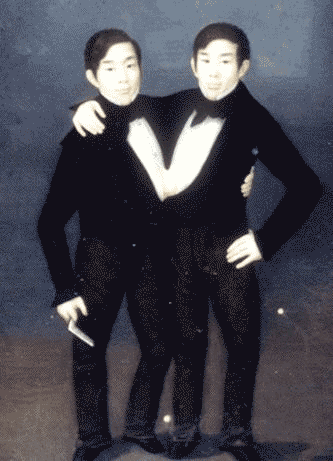
Chang and Eng Bunker, watercolor on ivory, 1835 or 1836
Mary and Eliza Chulkhurst, alleged names of the Biddenden Maids (per tradition, born in the 12th century) of Kent, England.[35] They are the earliest set of conjoined twins whose names are (purportedly) known.
Lazarus and Joannes Baptista Colloredo (1617-1646?) autosite-and-parasite pair
Helen and Judith of Szony (Hungary, 1701–1723) pygopagus
Chang and Eng Bunker (1811–1874), from Thailand (formerly Siam), joined by the areas around their xiphoid cartilages, but over time, the join stretched; the expression Siamese twins is derived from their case
Millie and Christine McCoy (July 11, 1851–October 8, 1912) American conjoined twins who went by the stage names "The Two-Headed Nightingale" and "The Eighth Wonder of the World." (oblique pygopagus)
Giacomo and Giovanni Battista Tocci (1875?-1912?) (dicephalus tetrabrachius dipus)
Born 20th century
Daisy and Violet Hilton of Brighton, England (1908–1969), actresses, appeared in the movies Freaks and Chained for Life. Pygopagus.
Lucio and Simplicio Godina of Samar, Philippines (1908–1936)
Masha and Dasha Krivoshlyapova of Moscow, Russia (1950–2003), rarest form of conjoined twins, one of few cases of dicephalus tetrabrachius tripus (two heads, four arms, three legs)
Ronnie and Donnie Galyon of Ohio (b. 1951), currently the world's oldest living conjoined twins, omphalopagus
Tjitske and Folkje de Vries of Mûnein, Netherlands (b. 1953)
Wariboko and Tamunotonye Davies born 25 July 1953 in Kano, Nigeria. Separated in London by team led by Ian Aird. Tamunotonye died postoperatively. Wariboko became a nurse.[36]
Lori and George Schappell born September 18, 1961, in Reading, Pennsylvania, American entertainers, craniopagus
Elisa and Lisa Hansen, Ogden, Utah. Born by Caesarean section 18 Oct 1977 were conjoined at the top of their head (craniopagus). They were separated 1979 after 16 hour surgery, were first to both survive surgery. Elisa works two jobs and help to care for her sister. They are the oldest of 6 siblings
Ladan and Laleh Bijani of Shiraz, Iran (1974–2003); died during separation surgery in Singapore. Craniopagus.
Viet and Duc Nguyen, born on February 25, 1981, in Kon Tum Province, Vietnam, and separated in 1988 in Ho Chi Minh City. Viet died on October 6, 2007. Ischiopagus.
Patrick and Benjamin Binder, separated in 1987 by team of doctors led by Ben Carson. Craniopagus.
Andrew and Alex Olson, born in 1987, separated in April 1988 at the University of Nebraska Medical Center. Omphalopagus.
Abigail and Brittany Hensel are dicephalic parapagus twins born March 7, 1990, in Carver County, Minnesota. Both graduated in 2012 from Bethel University, St. Paul, hired as teachers.
Tiesha and Iesha Turner (born 1991 in Texas) separated in 1992 at Texas Children's Hospital in Houston, Texas. Omphalopagus.
Joseph and Luka Banda (born January 23, 1997, in Zambia) separated in 1997 in South Africa by Ben Carson (with a later intervention in 2001 to artificially close their skulls). Craniopagus.
Ganga and Jamuna Mondal of India, born 1969 or 1970, known professionally as The Spider Girls and The Spider Sisters. Ischiopagus.
Carmen and Lupita Andrade were born in June 2000 in Veracruz, Mexico. They later moved to the United States for healthcare with their parents.[37]
Born 21st century
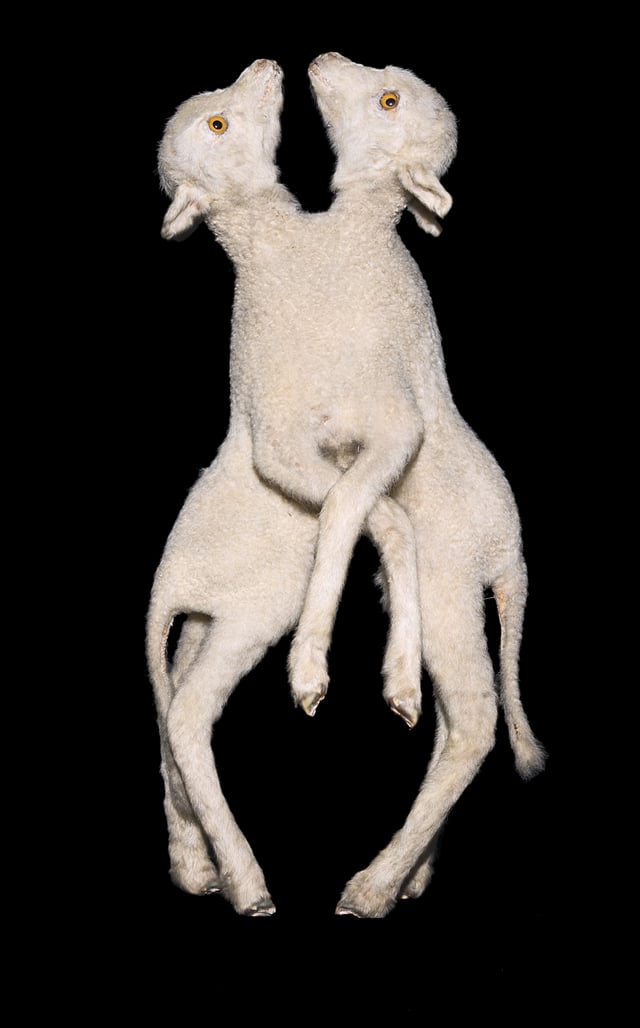
Conjoined twin lambs
Carl and Clarence Aguirre, born with vertical craniopagus in Silay City, Negros Occidental, on April 21, 2002. They were successfully separated in August 4, 2004.[38]
Tabea and Lea Block, from Lemgo, Germany, were born as craniopagus twins joined on the tops of their heads on August 9, 2003. The girls shared some major veins, but their brains were separate. They were separated on September 16, 2004, although Tabea died about 90 minutes later.[39]
Kendra and Maliyah Herrin, ischiopagus twins separated in 2006 at age 4[40]
Anastasia and Tatiana Dogaru born outside Rome of Lazio, Italy, on January 13, 2004. As craniopagus twins, the top of Tatiana's head is attached to the back of Anastasias's head.
Lakshmi Tatma (born 2005) was an ischiopagus conjoined twin born in Araria district in the state of Bihar, India. She had four arms and four legs, resulting from a joining at the pelvis with a headless undeveloped parasitic twin.[41]
Krista and Tatiana Hogan, Canadian twins conjoined at the head. Born October 25, 2006. Share part of their brain and can pass sensory information and thoughts between each other.
Trishna and Krishna from Bangladesh were born in December 2006. They are craniopagus twins, joined on the tops of their skulls and sharing a small amount of brain tissue. In 2009, they were separated in Melbourne, Australia.[42]
Maria and Teresa Tapia, born in the Dominican Republic on April 8, 2010. Conjoined by the liver, pancreas, and a small portion of their small intestine. Separation occurred on November 7, 2011.
Jesus and Emanuel de Nazaré born in Pará, Brazil on December 19, 2011, conjoined by the head.
Zheng Han Wei and Zheng Han Jing, born in China on August 11, 2013. Conjoined by their sternum, pericardium, and liver. In 2014, they were separated in Shanghai, China, at the Shanghai Children's Medical Center.[43][44]
Erin and Abby Delaney, born in Philadelphia, Pennsylvania USA on July 24, 2016. Conjoined by the head. They were successfully separated at Children's Hospital of Philadelphia on June 16, 2017.[45]
Marieme and Ndeye Ndiaye, twin girls born in Senegal in 2017, living in Cardiff, UK in 2019[46]
Safa and Mara Bibi, twin girls born in Hayatabad, Pakistan on January 17, 2017, coinjoined by the head. Successfully separated at Great Ormond Street Hospital in February 2019.
In fiction
Tamil actor Suriya portrays Vimalan and Akilan, conjoined twins in the 2012 film, Maattrraan.
The book The Girls, by Canadian novelist Lori Lansens, published in 2005, is the fictional autobiography of Canadian craniopagus twins Rose and Ruby Darlen with Slovakian background.
Irish author Sarah Crossan won the Carnegie Medal for her verse novel, One.[47] The story follows the life and survival of conjoined twin sisters. The book also won The Bookseller's 2016 prize for young adult fiction and the Irish Children's Book of the Year.
The Addams Family actresses Darlene and Maureen Sue Levin portray conjoined twins Flora and Fauna Amor in both The Addams Family and Addams Family Values.
The Farrelly brothers film Stuck on You depicts Bob and Walt Tenor, conjoined twins portrayed by Matt Damon and Greg Kinnear. 2003.
Duckman
CatDog depicts Cat and Dog, a hybrid of a dog and cat who are brothers.
Dragon Tales, a children's show, depicts Zak and Wheezie, a two-headed dragon that are brother and sister making them a dicephalic parapagus twins.
South Park features Nurse Gollum with a fetus attached to the side of her head, in what the show refers to as "Conjoined fetus syndrome".
The Simpsons features Hugo in "Treehouse of Horror VII", who is Bart Simpson's conjoined twin. They were separated at birth by Dr. Hibbert, and Hugo was imprisoned in the Simpsons' attic.
The Oblongs, depicts Biff Oblong (Randy Sklar) and Chip Oblong (Jason Sklar)—17-year-old conjoined twins who are attached at the waist and share a middle leg due to their valley's pollution and radiation.
In the DC Comics series Hitman, villain Moe and Joe Dubelz is a conjoined twin gangster. Moe was alive at the time of introduction, but Joe had already died and is, in fact, undergoing putrefaction.
In the episode "Humbug" of The X-Files, Vincent Schiavelli portrayed a circus performer named Lanny, with an underdeveloped conjoined twin named Leonard. The episode also includes a reference to Chang and Eng.
The Prophet of Yonwood has a reference to Chang and Eng when the main character, Nickie, finds a picture of them in her great-grandfather's old house in Siam.
In the anime Naruto, Sakon (左近) and his conjoined twin brother Ukon (右近) are the strongest of the Sound Four and count as one member due to their abilities to merge bodies and kill an opponent at a cellular level. They both serve as antagonists.
The Broadway musical Side Show depicts the lives of real-life conjoined twins Daisy and Violet Hilton, portrayed in the original Broadway production by Alice Ripley and Emily Skinner.
The American medical drama Grey's Anatomy featured several cases of conjoined twins.
The 2001 movie Not Another Teen Movie depicts Kara and Sara Fratelli, conjoined twins portrayed by Samaire Armstrong and Nectar Rose.
The musical group Evelyn, Evelyn depicts a pair of conjoined twin sisters—often referred to as "The Evelyn Sisters"—in many of their songs and music videos. The fictional sisters are shown to be child prostitutes in the music video for "Sandy Fishnets", and the song "Evelyn, Evelyn" describes their longing for privacy and to be separated from one another.
The Bride with White Hair, a 1993 Hong Kong movie, features conjoined twin villains.
The animated series Duckman featured Charles and Mambo, who are dicephalic parapagus twins whose heads share a body.
Fran Bow, a 2015 indie psychological horror game, includes Clara and Mia Buhalmet, a set of mentally ill conjoined twins, as characters. They were surgically sewn together, much like an experiment performed by Josef Mengele, also known as the Angel of Death, in which a pair of twins were sewn together back to back by blood vessels and organs, in an attempt to create conjoined twins.
The Peach Tree, a Korean novel and film, portrays conjoined twin brothers falling in love with the same woman.
The 1999 movie Twin Falls Idaho portrays conjoined twin brothers who are played by two non-conjoined identical twin brothers, one of whom directed the film, and both of whom co-wrote the screenplay.
In the fourth season of the American television series American Horror Story, American Horror Story: Freak Show, the main character Bette and Dot Tattler (Sarah Paulson in a dual role) are conjoined twin sisters (dicephalic parapagus—two heads side by side on one torso). This performance is done with the help of CGI.
In season two, episode eight of Rick and Morty, Michael and Pichael Thompson are depicted as conjoined twins hosting separate TV shows at the same time.
In the Cirque Du Soleil show Kurios: Cabinetes des Curiosities, a pair of conjoined twins are among the Seeker's collection. They later split during an aerial straps duo, and reunite for the rest of the show.
The film Charulatha stars Priyamani as a conjoined twin.
In the movie Jagga Jasoos, starring Ranbir Kapoor and Katrina Kaif, Basheer Alexander is shown with two heads.
On the television series Ruby Gloom, the characters Frank and Len are conjoined twins who comprise a rock group called RIP.
In the film Monsters University, two of the members of fictitious fraternity Oozma Kappa are named Terri and Terry Perry. They are dicephalic parapagus twins where they have four arms and share the same tentacles that are in place of their legs.
In the children's cartoon Steven Universe, the Rutile twins are conjoined.
Fire and Water are conjoined twins in Chris Abani's 2014 novel The Secret History of Las Vegas.
The Knick portrays conjoined twins Zoya and Nika, who share a liver. They are successfully separated by the doctors.
Brian Aldiss's 1977 novel Brothers of the Head depicts conjoined twins who become rock stars. In the 2005 film version, they are played by non-conjoined identical twins Harry Treadaway and Luke Treadaway.
See also
Medical law
Monoamniotic twins
Polycephaly